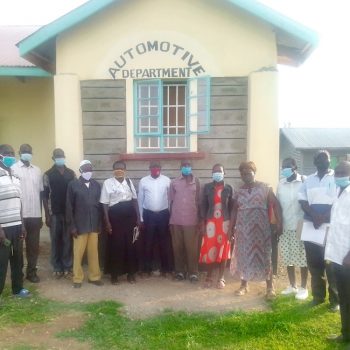 The Got Matar Community has made huge strides towards achieving its goals for opening up high quality educational opportunities within the area for people born at and since the peak of the AIDS epidemic. The Secondary School is thriving and is no longer significantly dependent on external donor contributions. Capital investment needs are met mainly by Kenya Government sources and its bursary programme is getting increasing support from former students, many of whom had received bursaries themselves.
The Got Matar Community has made huge strides towards achieving its goals for opening up high quality educational opportunities within the area for people born at and since the peak of the AIDS epidemic. The Secondary School is thriving and is no longer significantly dependent on external donor contributions. Capital investment needs are met mainly by Kenya Government sources and its bursary programme is getting increasing support from former students, many of whom had received bursaries themselves.
The development of the Institute of Technology started on a very small scale in 2012, about 6 years after the beginning of the Secondary School building programme. With the demand for donor investment in the Secondary School declining, it became possible to focus more resources on buying equipment for the IoT. It was not until 2016-17, however, that the development of purpose-built training workshops began on its new campus.
To the extent that funds have been available, excellent progress has been made with the construction programme, with 6 training workshops completed. These provide high quality facilities for both classroom and practical training and their presence is attracting increasing numbers of students.
The immediate investment requirements are to complete another four training workshops, to build a Girls’ Hostel and to construct an office as well as rooms for teachers. If funds are available, the aim is to complete the ICT training workshop and the Girls’ Hostel in 2021. A further 2 to 3 years will probably be needed for construction and equipment of the other buildings.
As the quality of the facilities improves, the demand from students for places is expected to grow.
The Community owns and operates the IoT and hopes to be able to continue to do so. At the moment part of its operating costs is met from donor contributions, but, since the Institute has reopened in October 2020 after relaxation of Coronavirus restrictions, the Board of Governors has started to look at ways of increasing revenues.
The biggest source of income comes from tuition fees which now average Euro 45 equivalent per year, compared to operating costs of over Euro 100 per pupil per year. The dilemma is that any increase in fees will tend to reduce enrolment and put attendance at the IoT out of reach of the poorest families. The Board is considering raising fees significantly but using part of the extra income to subsidise attendance by the poorest applicants.
The IoT has always earned some income from the sale of goods and services by each of the Departments. One of the newest of such initiatives is the Automotive Department’s programme for providing driving lessons in its newly acquired minibus. Furniture for new buildings (for example, desks, bunks, curtains) has been made by IOT students and they are also making school uniforms for the Secondary School. Some students earn money with which to pay for their tuition fees while gaining practical work experience by engaging in the construction of the new buildings.
The Board is looking at ways of expanding these income sources. It is also considering options for introducing shirt courses that could make use of its facilities and staff during holiday periods and evenings.
The aim is for the IoT to become financial self-sustaining as quickly as possible and for it to eventually generate profits for the Community that can be ploughed back into other development initiatives.
Grace Andiki, the Coordinator, has recently started consultations amongst young people, especially girls, who have benefited from the Community’s education programmes, with the aim of exploring ways in which the IoT could enhance the ways in which the results of better education are reflected in improvements in the wellbeing of the community and the management of natural resources. Whatever emerges from these discussions could have an important impact on the future shape of the IoT and its demand on resources for poverty reduction and environmental stewardship.
